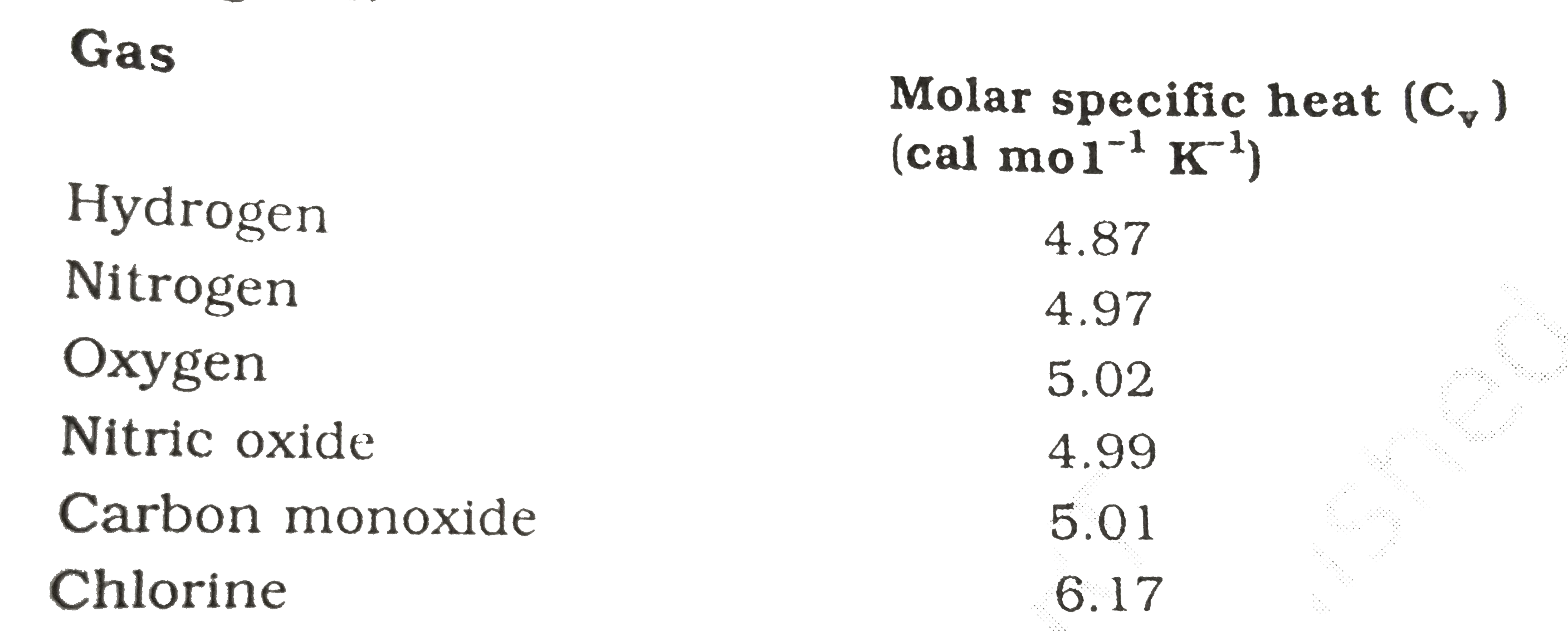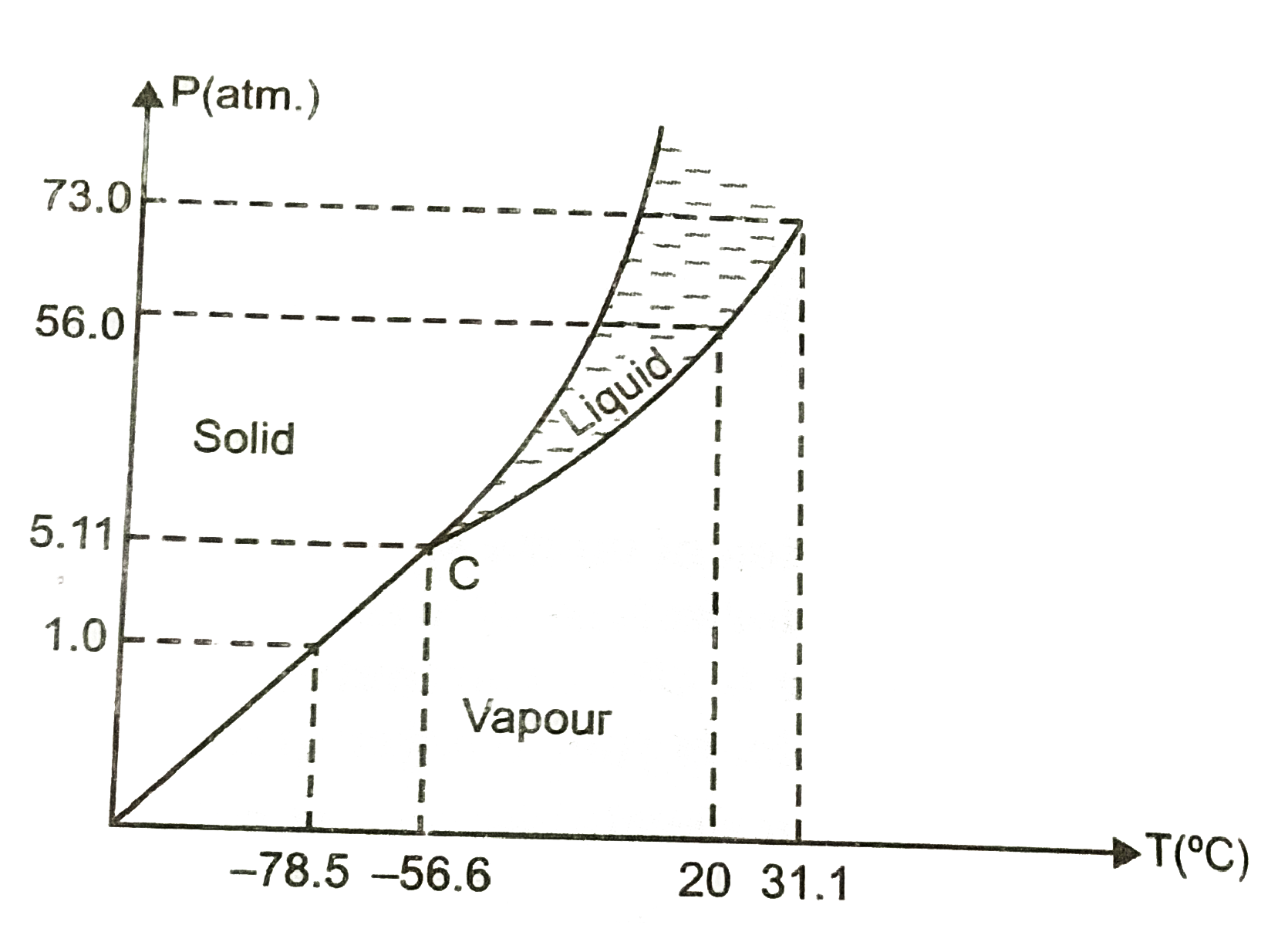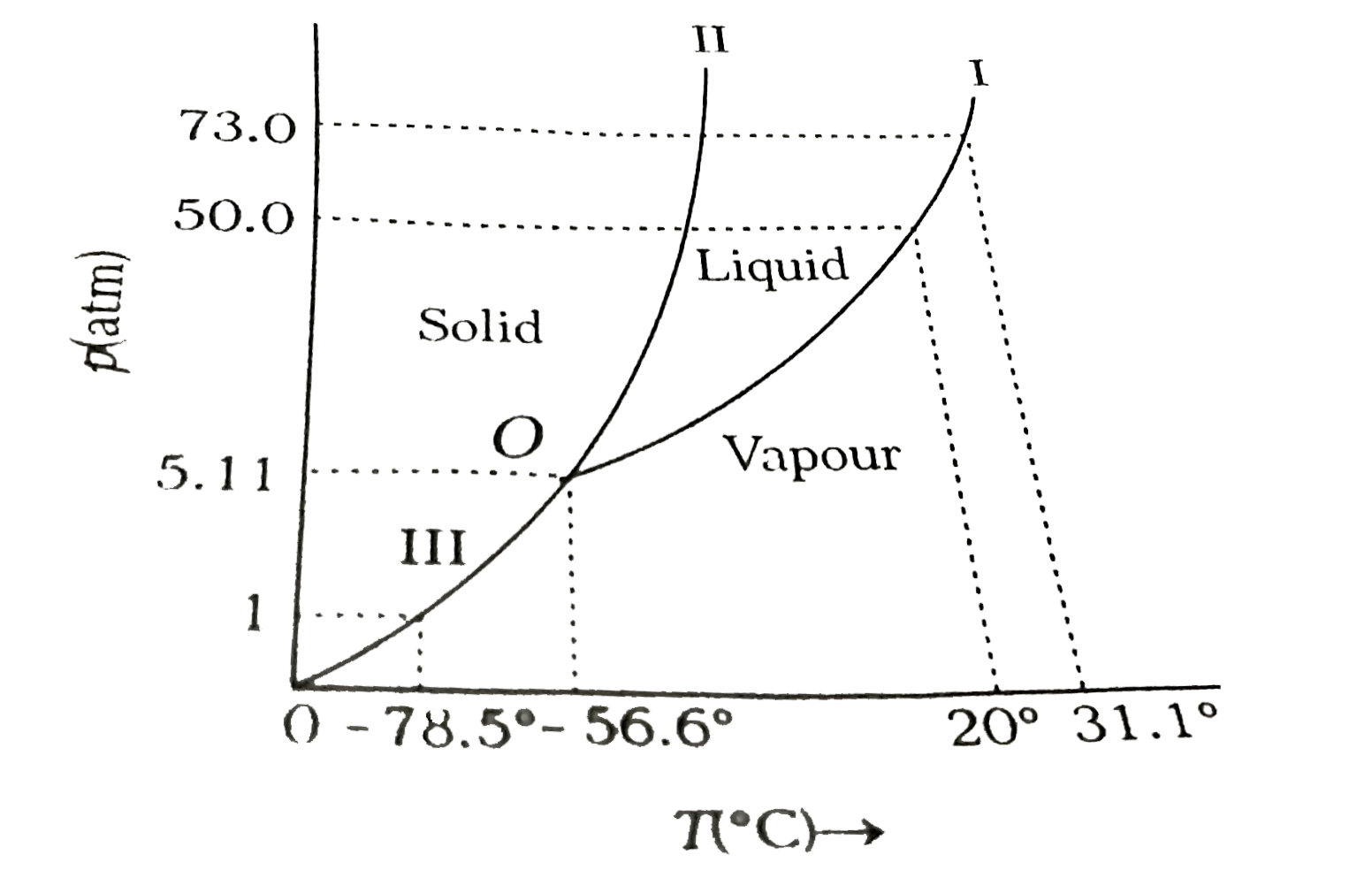Complete Solutions to EXERCISES of chapter THERMAL PROPERTIME OF MATTER of Class 11 book with complete answers and questions
| Class 11 | PHYSICS |
| Chapter | THERMAL PROPERTIME OF MATTER |
| NCERT TAMIL | EXERCISES |
| Number Of Questions | 31 |
| Academic Year | 2023-24 |
The triple point of neon and carbon dioxide are `24.57K` and `216.55K` respectively. Express these temperature on the Celsius and Fahrenheit scales.
View SolutionTwo absolute scales `A` and `B` have triple points of water defined to be `200A` and `350B`. What is the relation between `T_(A)` and `T_(B)`?
View SolutionThe electrical resistance in ohms of a certain thermometer varies with temperature ac cording to the approximate law: `R =R_(0)[1+alpha(T-T_(0))]`
The resistances is `101.6 Omega` at the triple-point of water `273.16K`, and `165.5 Omega` at the normal melting point of lead `(600.5K)`. What is the temperature when the resistance is `123.4 Omega`?
View SolutionAnswer the following :
(a) The triple-point of water is a standard fixed point in modern thermometry. Why ? What is wrong in taking the melting point of ice and the boiling point of water as standard fixed points (as was originally done in the Celsius scale) ?
(b) There were two fixed points in the original Celsius scale as mentioned above which were assigned the number `0^(@)C" and "100^(@)C` respectively. On the absolute scale, one of the fixed points is the triple-point of water, which on the Kelvin absolute scale is assigned the number 273.16 K. What is the other fixed point on this (Kelvin) scale ?
(c ) The absolute temperature (Kelvin scale) T is related to the temperature `t_(c)` on the Celsius scale by
`t_(c)=T-273.15`
Why do we have 273.15 in this relation, and not 273.16 ?
(d) What is the temperature of the triple-point of water on an absolute scale whose unit interval size is equal to that of the Fahrenheit scale ?
View SolutionAnswer the following :
(a) The triple-point of water is a standard fixed point in modern thermometry. Why ? What is wrong in taking the melting point of ice and the boiling point of water as standard fixed points (as was originally done in the Celsius scale) ?
(b) There were two fixed points in the original Celsius scale as mentioned above which were assigned the number `0^(@)C" and "100^(@)C` respectively. On the absolute scale, one of the fixed points is the triple-point of water, which on the Kelvin absolute scale is assigned the number 273.16 K. What is the other fixed point on this (Kelvin) scale ?
(c ) The absolute temperature (Kelvin scale) T is related to the temperature `t_(c)` on the Celsius scale by
`t_(c)=T-273.15`
Why do we have 273.15 in this relation, and not 273.16 ?
(d) What is the temperature of the triple-point of water on an absolute scale whose unit interval size is equal to that of the Fahrenheit scale ?
View SolutionAnswer the following :
(a) The triple-point of water is a standard fixed point in modern thermometry. Why ? What is wrong in taking the melting point of ice and the boiling point of water as standard fixed points (as was originally done in the Celsius scale) ?
(b) There were two fixed points in the original Celsius scale as mentioned above which were assigned the number `0^(@)C" and "100^(@)C` respectively. On the absolute scale, one of the fixed points is the triple-point of water, which on the Kelvin absolute scale is assigned the number 273.16 K. What is the other fixed point on this (Kelvin) scale ?
(c ) The absolute temperature (Kelvin scale) T is related to the temperature `t_(c)` on the Celsius scale by
`t_(c)=T-273.15`
Why do we have 273.15 in this relation, and not 273.16 ?
(d) What is the temperature of the triple-point of water on an absolute scale whose unit interval size is equal to that of the Fahrenheit scale ?
View SolutionAnswer the following :
(a) The triple-point of water is a standard fixed point in modern thermometry. Why ? What is wrong in taking the melting point of ice and the boiling point of water as standard fixed points (as was originally done in the Celsius scale) ?
(b) There were two fixed points in the original Celsius scale as mentioned above which were assigned the number `0^(@)C" and "100^(@)C` respectively. On the absolute scale, one of the fixed points is the triple-point of water, which on the Kelvin absolute scale is assigned the number 273.16 K. What is the other fixed point on this (Kelvin) scale ?
(c ) The absolute temperature (Kelvin scale) T is related to the temperature `t_(c)` on the Celsius scale by
`t_(c)=T-273.15`
Why do we have 273.15 in this relation, and not 273.16 ?
(d) What is the temperature of the triple-point of water on an absolute scale whose unit interval size is equal to that of the Fahrenheit scale ?
View SolutionTwo ideal gas thermometer `A` and `B` use oxygen and hydrogen respectively . The following observations are made:
Temperature, Pressure therometer A, Pressure therometer B
Triple point of water, `1.250xx10^(5)Pa`, `0.200xx10^(5)Pa`
Normal melting point of sulphur, ` 1.797xx10^(5)Pa`, `0.287xx10^(5)Pa`
(a) What is the absolute temperature of normal melting point of sulphur as read by thermometers `A` and `B` ?
(b) What do you think is the reason for the slightly different answers from `A` and `B` ? (The thermometers are not faulty). what further procedure is needed in the experiment to reduce the discrepancy between the two readings.
View SolutionA steel tape 1m long is correctly calibrated for a temperature of `27^(@)C`. The length of a steel rod measured by this tape is found to be `63.0cm` on a hot day when the temperature is `45.0^(@)C`. What is the acutual length of the steel rod on that day? what is the length of the same steel rod on a day when the temperature is `27.0^(@)C` ? coefficient of linear expansion of steel ` = 1.20xx10^(-5) .^(@)C^(-1)`.
View Solutiona large steel wheel is to be fitted on to a shaft of the same material. At `27^(@)C`, the outer diameter of the shaft is `8.70cm` and the diameter of the central hole in the wheel is `8.69cm` . The shaft is cooled using 'dry ice' , At what temperature of the shaft does the wheel slip on the shaft? Assume coefficient of linear expansion of the steel to be constant over the required temperature range: `alpha_(steel) = 1.20xx10^(-5)K^(-1)`.
View SolutionA hole is drilled in a copper sheet. The diameter of the hole is 4.24cm at `27.0^(@)C`. What is the change in the diameter of the when the sheet is heated to `227^(@)C`? Coefficient of linear expansion of copper `=1.70xx10^-5""^(@) C^(-1)`?
View SolutionA brass wire `1.8 m` long at `27^(@)C` is held taut with little tension between two rigid supports. If the wire cooled to a temperature of `-39^(@)C`, what is the tension developed in the wire, if its diameter is `2.0 mm`? Coefficient of linear expansion of brass `= 2.0 xx 10^(-5)//^(@)C`, Young's modulus of brass `= 0.91 xx 10^(11) Pa`.
View SolutionA brass rod of length 50 cm and diameter 3.0 mm is joined to a steel rod of the same length and diameter. What is the change in length of the combined rod at `250^(@)C`, if the original lengths are at `40.0^(@)C`? Is there a 'thermal stress' developed at the junction ? The ends of the rod are free to expand. Coefficient of linear expansion of brass `= 2.0 xx 10^(-5).^(@)C^(-1)` and that of steel `=1.2 xx 10^(-5).^(@)C^(-1)`.
View SolutionThe coefficient of volume expansion of glycerine is `49 xx 10^(-5)//^(@)C`. What is the fractional change in its density (approx.) for `30^(@)C` rise in temperature?
View SolutionA `10 kW` drilling machine is used to drill a bore in a small aluminium block of mass `8.0 kg`. How much is the rise in temperature of the block in `2.5` minutes, assuming `50%` of power is used up in heating the machine itself or lost to the surrounding? Specific heat of aluminium `= 0.91 J//g^(@)C`.
View SolutionA copper block of mass `2.5 kg` is heated in a furnace to a temperature of `500^(@)C` and then placed on a large ice block. What is the maximum amount (approx.) of ice that can melt? (Specific heat copper `= 0.39 J//g^(@)C` heat of fusion of water `= 335 J//g`).
View SolutionIn an experiment on the specific heat of a metal a 0.20 kg block of the metal at `150^(@)`C is dropped in a copper calorimeter (of water equivalent 0.025 kg) containing 150 cc of water at `27^(@)`C. The final temperature is `40^(@)`C. Calcualte the specific heat of the metal. If heat losses to the surroundings are not negligible, is our answer greater or smaller than the actual value of specific heat of the metal?
View SolutionGiven below are observations on molar specific heats at room temperature of some common gases

The measured molar specific heats of these gases are markedly different from those for monoatomic gases. Typically, molar specific heat of a monoatomic gas is 2.92 cal/mol K. Explain this difference. What can you infer from the somewhat larger (than the rest) value for chlorine ?
View SolutionA child running a temperature of `101^F` is given and antipyrin (i.e. a madicine that lowers fever) which cause an increase in the rate of evaporation of sweat from his body. If the fever is brought down to `98^@F` in 20 min., what is the averatge rate of extra evaporation caused, by the drug ? Assume the evaporation mechanism to the only way by which heat is lost. The mass of the child is 30 kg. The specific heat of human body is approximately the same as that of water and latent heat of evaporation of water at that temperature is about `580 cal. g^(-1).`
View SolutionA thermocole cubical icebox of side 30 cm has a thickness of 5.0 cm if 4.0 kg of ice are put ini the box, estimate the amount of ice remaining after 6 h. The outside temperature is `45^@C` and coefficient of thermal conductivity of thermocole`=0.01 J//kg`.
View SolutionA brass boiler has a base area of `0.15m^2` and thickness 1 cm. It boils water at the rate of 6 kg per minute when placed on a gas stove. Estimate the temperature of the part of the flame in contact with the boiler. Thermal conductivity of brass is `=109Js^(-1)m^(-1)K^(-1)`, Heat of vapourisation of water is `2256xx10^3Jkg^(-1)`
View SolutionExplain why : (a) A body with large reflectivity is a poor emitter. (b) A brass tumbler feels much colder then a wooden tray on a chilly day. (c ) an optical pyrometer (for measuring high temperatures) calibrated for an ideal black body correct value for the temperature when the same piece is in the furnace. (d) The earth without its atmosphere would be inshospitably cold. (e ) Heating system based on circulation of steam are more effecient in warming a building than those based on circulation of hot water.
View SolutionA body cools from `80^(@)C` to `50^(@)`C in 5 minutes. Calculate the time it takes to cool from `60^(@)C` to `30^(@)C`. The temperature of the surroundings is `20^(@)C`
View SolutionAnswer the following question beased on tbhe P-T phase diagram of carbon dioxide.

(a) At what temperature and pressure can the solid, liquid and vapour phases of `CO_2` co-exist is equilibrium ? (b) What is the effect of decrease of pressure on the fusion and bolling point of `CO_2` ? (c ) What are the critical temperature and pressure for `CO_2` ? What is their significane ? (d) Is `CO_2` solid, liquid or gas at (a) ` -70^@C` under 1 atm, (b) `-60^@C` under 10 atm, (c) `15^@C` under 56 atm ?
View SolutionAnswer the following question beased on tbhe P-T phase diagram of carbon dioxide.

(a) At what temperature and pressure can the solid, liquid and vapour phases of `CO_2` co-exist is equilibrium ? (b) What is the effect of decrease of pressure on the fusion and bolling point of `CO_2` ? (c ) What are the critical temperature and pressure for `CO_2` ? What is their significane ? (d) Is `CO_2` solid, liquid or gas at (a) ` -70^@C` under 1 atm, (b) `-60^@C` under 10 atm, (c) `15^@C` under 56 atm ?
View SolutionAnswer the following questions based on the p-T phase diagram of carbon dioxide as shown in the figure .
(i) At what temperature and pressure can the solid , liquid and vapour phases of `C0_(2)` co-exist in equilibrium?
(ii) What is the effect of decrease of pressure on the fusion and boiling point of `C0_(2)` ?
(iii) What are the critical temperature and pressure for `C0_(2)` ? what is their significance ?
(iv) Is `C0_(2)` solid , liquid, or gas at (a) `-70^(@)C `under 1 atm (b) `-60^(@)C` under 10 atm (c) `15^(@)C` under 56 atm ?

View SolutionAnswer the following questions based on the p-T phase diagram of carbon dioxide as shown in the figure .
(i) At what temperature and pressure can the solid , liquid and vapour phases of `C0_(2)` co-exist in equilibrium?
(ii) What is the effect of decrease of pressure on the fusion and boiling point of `C0_(2)` ?
(iii) What are the critical temperature and pressure for `C0_(2)` ? what is their significance ?
(iv) Is `C0_(2)` solid , liquid, or gas at (a) `-70^(@)C `under 1 atm (b) `-60^(@)C` under 10 atm (c) `15^(@)C` under 56 atm ?

View SolutionAnswer the following questions based on the P – T phase diagram of `CO_(2)`:
(a) `CO_(2)` at 1 atm pressure and temperature` – 60^(@)C` is compressed isothermally. Does it go through a liquid phase ?
(b) What happens when `CO_(2)` at 4 atm pressure is cooled from room temperature at constant pressure ?
(c) Describe qualitatively the changes in a given mass of solid `CO_(2)` at 10 atm pressure and temperature `–65^(@)C` as it is heated up to room temperature at constant pressure.
(d) `CO_(2)` is heated to a temperature `70^(@)C` and compressed isothermally. What changes in its properties do you expect to observe ?
View SolutionAnswer the following questions based on the P – T phase diagram of `CO_(2)`:
(a) `CO_(2)` at 1 atm pressure and temperature` – 60^(@)C` is compressed isothermally. Does it go through a liquid phase ?
(b) What happens when `CO_(2)` at 4 atm pressure is cooled from room temperature at constant pressure ?
(c) Describe qualitatively the changes in a given mass of solid `CO_(2)` at 10 atm pressure and temperature `–65^(@)C` as it is heated up to room temperature at constant pressure.
(d) `CO_(2)` is heated to a temperature `70^(@)C` and compressed isothermally. What changes in its properties do you expect to observe ?
View SolutionAnswer the following questions based on the P – T phase diagram of `CO_(2)`:
(a) `CO_(2)` at 1 atm pressure and temperature` – 60^(@)C` is compressed isothermally. Does it go through a liquid phase ?
(b) What happens when `CO_(2)` at 4 atm pressure is cooled from room temperature at constant pressure ?
(c) Describe qualitatively the changes in a given mass of solid `CO_(2)` at 10 atm pressure and temperature `–65^(@)C` as it is heated up to room temperature at constant pressure.
(d) `CO_(2)` is heated to a temperature `70^(@)C` and compressed isothermally. What changes in its properties do you expect to observe ?
View SolutionAnswer the following questions based on the P – T phase diagram of `CO_(2)`:
(a) `CO_(2)` at 1 atm pressure and temperature` – 60^(@)C` is compressed isothermally. Does it go through a liquid phase ?
(b) What happens when `CO_(2)` at 4 atm pressure is cooled from room temperature at constant pressure ?
(c) Describe qualitatively the changes in a given mass of solid `CO_(2)` at 10 atm pressure and temperature `–65^(@)C` as it is heated up to room temperature at constant pressure.
(d) `CO_(2)` is heated to a temperature `70^(@)C` and compressed isothermally. What changes in its properties do you expect to observe ?
View Solution
EXERCISES questions and complete solutions for chapter THERMAL PROPERTIME OF MATTER of FULL MARKS PHYSICS(TAMIL) of Class 11